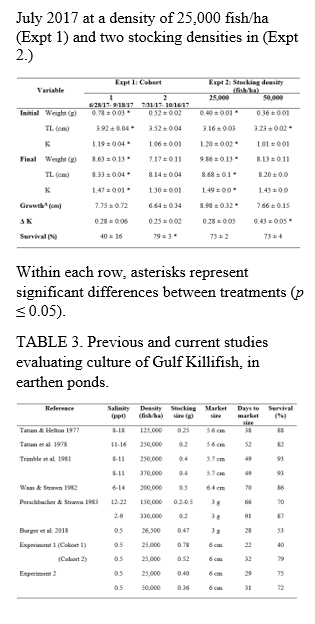COMPARISON OF STOCKING TIME AND DENSITY ON GULF KILLIFISH GROWTH IN FRESHWATER PONDS
The Gulf Killifish (Fundulus grandis) is a popular baitfish and a candidate for commercial-scale production. For inland production, ponds may need to be stocked at different times and densities to meet market demands. Therefore, in Experiment 1, juveniles were stocked into freshwater ponds at a density of 25,000 fish/ha, with two cohorts (mean total length (TL) = 3.92; 3.52 cm) stocked 1 month apart and evaluated for 12 weeks. Cohort 1 had a lower overall survival (40%) than cohort 2 (79%); with no difference between mean final TL (8.46; 8.00 cm); reaching a market size of 6 cm in 22 days and 32 days, respectively. In Experiment 2, juveniles (mean TL= 3.16; 3.23 cm) were stocked into freshwater ponds at two densities (25,000 fish/ha and 50,000 fish/ha). Mean final TL was greater in the lower stocking density (8.68 cm) than the higher stocking density (8.20 cm); with no differences in survival between treatments (75; 72%) respectively. Lower stocking and higher stocking densities reached a market size of 6 cm in 29 and 31 days, respectively. These results suggest that multiple cohorts can be stocked and grown to market size in one season at a stocking density of 50,000 fish/ha.
